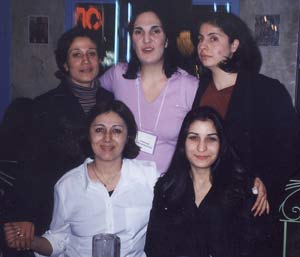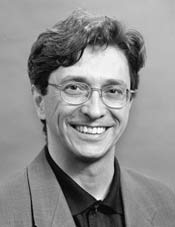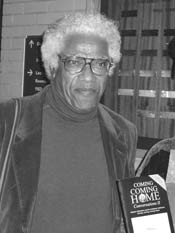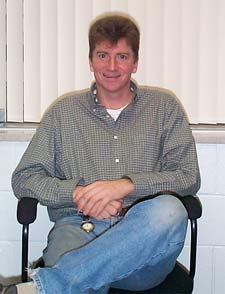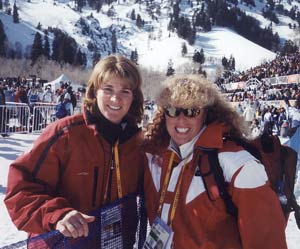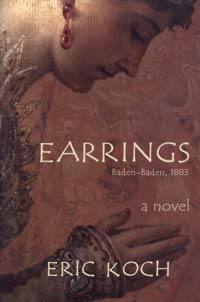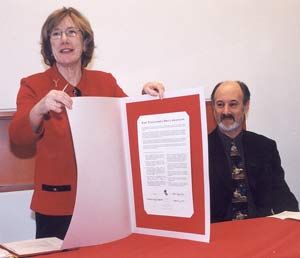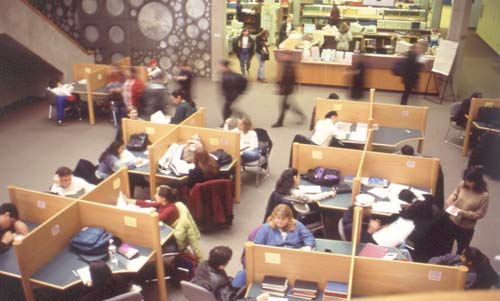|
|||||||||||||||||||||||||||||
|
|
|||||||||||||||||||||||||||||
| | |
| | VOLUME 32, NUMBER 15 | WEDNESDAY, APRIL 3, 2002 | ISSN 1199-5246 | |
| | |||
|
 |
Astronomically Speaking: The Hubble Space Telescope (Part 1) By Paul Delaney 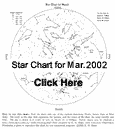
It is hard to believe that four servicing missions by the space shuttle to the Hubble Space Telescope (HST) have taken place. Breathlessly the world watched in awe as team after team of space-walking astronauts performed long and complex extra-vehicular activities (EVAs) to upgrade and refurbish the telescope. Solar panels were replaced on two occasions, new computer systems, scientific instrument packages exchanged to name but a few of the items handled during the various missions. The astronauts accomplished their tasks on schedule and with remarkable ease. I am not sure what the official count of time in space for these exploits is but it would number close to 18 space-walks and probably 160 hours of EVA time. The images from HST that have been delivered since the servicing missions have been simply magnificent and the research that has flowed from HST, exhilarating. On April 24 this year the HST will celebrate its 12th anniversary in orbit. In 1990, the space shuttle Discovery thundered into a clear Florida sky, carrying in its payload bay the most sophisticated astronomical instrument ever to have been created and one of the heaviest satellites to be deployed. HST is a reflecting telescope with a 2.4-metre diameter primary mirror. It was originally equipped with five instruments to observe and analyze the universe. One of these instruments, the High Speed Photometer, was removed during the servicing mission in December 1993 and replaced by COSTAR (more in a moment). Physically the telescope is in excess of 13 metres in length and weighs in at 11,600 kilograms. HST is designed to operate for over 15 years (NASA expects at least 20 years) and have replaceable instruments carried to it periodically by the shuttle fleet. From its orbital vantage point, it can see cleanly and clearly into the universe at all times and at frequencies that its terrestrial counterparts cannot ever reach. As everyone in the world must be aware, the telescope mirror is flawed. The grinding error that exists is the result of too much glass having been removed near the edge of the mirror. The amount in question is about one tenth the thickness of a human hair strand but it was enough to slightly blur the images generated by the telescope. In hindsight, things should have been done differently. The astronomical community now knows that the first servicing mission to HST in December 1993 (STS 61) was an outstanding success. The first images from HST after Endeavor de-orbited showed remarkable clarity. Ecstasy and relief rang throughout NASA and many other places as it was realized that HST would be able to deliver outstanding images and science of the universe. The feat of correcting the spherical aberration that had plagued HST was accomplished using a new camera, WFPC 2 (Wide Field Planetary Camera, second generation instrument) and COSTAR (Corrective Optical Space Telescope Axial Replacement), a 250 kilogram mass, shoe box-sized device that contains 12 DC motors, 10 mirrors, 4 arms and countless wires and sensors. In short, both WFPC 2 and COSTAR supply the opposite amount of spherical aberration to the light reflected from the primary mirror allowing images to be concentrated into a point less than one tenth of one second of arc in diameter. (For comparison, the moon is 1,800 seconds of arc in diameter.) The design and construction of COSTAR was a major triumph and an absolute delight to astronomers everywhere. COSTAR replaced the original high speed photometer and WFPC 2 replaced WFPC 1. During the 10-day second servicing mission (STS-82) in February 1997, the seven astronauts aboard the space shuttle Discovery installed two technologically advanced, second generation instruments. The Near Infrared Camera and Multi-Object Spectrometer (NICMOS) is able to observe the universe in the infrared wavelengths. (Unbeknownst to this mission, NICMOS would become the focus of the fourth servicing mission as its onboard coolant system would fail prematurely rendering it inoperable.) The second instrument was the versatile Space Telescope Imaging Spectrograph (STIS). The new instruments replaced the Goddard High Resolution Spectrograph and the Faint Object Spectrograph. The third servicing mission (STS 103) was in December 1999 and was an unexpected but crucial maintenance mission. HST had been commanded into "safe mode" because of the failure of its onboard gyroscopic stabilizers and all science functions had been suspended. The brief but very successful mission replaced all six gyroscopes and three fine-guidance sensors as well as a number of other miscellaneous repairs. Following the fourth shuttle servicing mission, the HST contains a third generation camera on board, the Advanced Camera for Surveys (ACS). This instrument replaces the last of the original HST instruments, the Faint Object Camera (FOC) and has a much larger field of view than the primary onboard camera, WFPC 2, and is more sensitive meaning that the HST now has 10-times more "discovery power" than it had before the flight of Columbia in February 2002. It seems that at every turn, this telescope offers the astronomical community marvellous potential for even more exciting discoveries. For those interested in the history of the various servicing missions, I direct you to http://hubble.stsci.edu/sci.d.tech/team_hubble/servicing_missions/ . Keep a watch for new HST images visiting a newsstand near you ... the wait has been worth it! In the next column we'll look at the science of HST and what the next generation space telescope (NGST) will be. York University Observatory continues its public viewing program every Wednesday evening in April, from 8 to 10pm. On Saturday, April 20, International Astronomy Day, the observatory will be open from 4 to 10pm. Full details are available at www.astro.yorku.ca/observatory . Join the staff to gaze at the planets of our Solar System, the Moon (if visible) and the other wonders of the night sky. Admission is free but donations are always welcome. Dress appropriately as the domes are neither heated nor cooled. For more information, phone 416-736-2100, ext. 77773. Paul Delaney is senior lecturer in the Department of Physics and Astronomy, and master of Bethune College at York University.
| ||
|
 |
Uppal...and coming - York PhD student publishes her fourth book By Carol Bishop 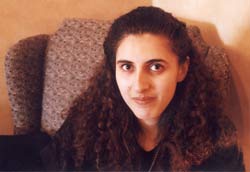
Priscila Uppal Creative writing teacher and first time novelist, Priscila Uppal can't recall a time when she didn't know how to read and write. "I can't remember ever asking anyone to read to me. I was never read to as a child, I was just given the books." So it seemed a natural progression for her to start writing books. Uppal's first novel The Divine Economy of Salvation published by Doubleday came out in February to positive reviews. This is the fourth book for the 27-year-old York PhD student and teacher. Her three collections of poetry are How to Draw Blood from a Stone, Confessions of a Fertility Expert and Pretending to Die. The Divine Economy of Salvation is a page-turner of a novel telling the tale of crimes of youth that go on to haunt adult life. The book's protagonist, Angela, is a nun atoning for a deed done while a student at an all-girl Catholic convent in Ottawa. As a 14-year-old, Angela was sent away to boarding school. Lonely and neglected, she finds solace with a group of girls who call themselves The Sisterhood. One girl's initiation takes a violent turn. Twenty-five years later, buried evidence of her death resurfaces and threatens to shatter the sheltered simplicity of Angela's life in the nunnery. Uppal has first-hand experience of a Catholic education. She and her brother attended Catholic schools in Ottawa as a compromise solution for her parents, her father being a Punjabi-speaking Sikh and her mother a Brazilian practitioner of a form of voodoo. "They could agree between themselves that Jesus was a nice man," says Uppal. One of her many fascinations is the religious life and issues of faith. She chose York specifically to do an undergraduate degree in English and creative writing. Now she's back at York teaching the same course she took only eight years ago. Uppal is course director for Humanities 2900, the foundation course for the undergraduate creative writing program. "I was helped so much in this program. I benefited so much from writers who encouraged me, showing me the ropes, really being mentored here. So to be able to do that for other writers is a privilege." She had never met a professional writer until she came to York. Recognizing her talent as she progressed through the creative writing program, professors and fellow writers Richard Teleky and Susan Swan brought her work to the attention of Barry Callaghan, founder and editor of the literary quarterly Exiles, who published 10 of her poems. Then Canadian literary agent Bruce Westwood, who represents Katherine Govier and Timothy Findley among others, read one of Uppal's short stories and got in touch with her. Doubleday bought her novel with only 60 sample pages. However, she had short stories and three books of published poetry as proof of her considerable talent. Quietly self-assured and unapologetically ambitious, Uppal appears wise beyond her years. She describes herself as an observer and is fascinated with the life stories of many of her older friends. The young writer calls herself lucky but also acknowledges that she has worked steadily towards her goals. "I love the definition of success - opportunity meets preparation. So you have to have the luck to have the opportunity, but after that you have to be prepared to take advantage of it." "I really am a person who looks around and tries to empathize with everything I see. To me that's my purpose in engaging with the world - trying to connect with other human beings and trying to understand their wants and their sufferings. Paradoxically that means that I have to withdraw from them for long periods of time." "I'm a person who experiences the world very intensely and therefore has a great desire to understand those emotions and to understand the people around me. For myself, writing comes from a great place of confusion. I don't think I have something to tell someone else. I usually start off with a scene or an image that confuses me and I'm trying to figure it out." Uppal writes her fiction and poetry at the same time. "When I'm editing one, I'm actually writing the other form all the time to keep both sides of my brain working, the editorial and analytical side and the other that just generates and generates material so I can be so prolific. I always work on a few things at once. I figure that way if something isn't working, you're not so invested in it that you can't see it properly. That's always been big for me. I throw out about half of what I write." Her pace of life doesn't promise to slow down. She is in the midst of a book tour for The Divine Economy of Salvation. She has done whistle stop visits to Montreal and Ottawa and been interviewed by national and local radio, television and newspapers in Toronto. She is putting together a collection of short stories and has written a few scenes for her next novel. And she plans to have her dissertation on Canadian contemporary elegies, poems that respond to death, completed by December 2002. Uppal's career parallels in many ways that of Margaret Atwood who writes both poetry and fiction and completed two novels in her early twenties while working on a PhD and teaching first-year English. She acknowledges the great debt younger writers owe to the original CanLit group. "We can write because of the Atwood generation. A lot of them broke down the stereotypes about women and a lot of the different genres. I feel that our generation of new writers have been given a new freedom because they have already broken down so many structures that we can actually plot out our own. So this new generation of writers couldn't have existed without the generation before us."
| ||
|
|
Women rebuilding Afghanistan
| ||
|
|
Physics Nobel laureate proved a 70-year-old theory By Martha Tancock, with Susan Bigelow 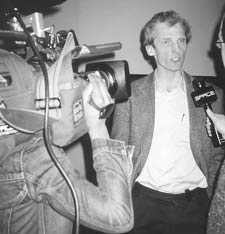
In physicist Wolfgang Ketterle's opinion, the most "beautiful aspects of nature can only be revealed at low temperatures." The Nobel Prize-winning scientist should know. He had to cool sodium to within a millionth of 0 Kelvin (minus 273.15 Celsius) to be one of the first people ever to see "atoms march in lock step." Wolfgang Ketterle He was one of the three scientists who finally created the Bose-Einstein condensate (BEC) theorized 70 years previously by Albert Einstein and Satyendranath Bose. They predicted that if a gas is cooled to a very low temperature its atoms will slow down and begin behaving in concert like a single wave, the way light particles (photons) do in lasers. At about the same time Ketterle produced the BEC by cooling sodium atoms, scientists Eric A. Cornell and Carl E. Wieman produced it by cooling rubidium atoms. All three shared a Nobel Prize for physics in 2001. York's Department of Physics and Astronomy invited Ketterle to describe his journey of discovery to York students and faculty on Feb. 5. Matter behaved like light It took Ketterle 20 years of refining an atom trap and a cooling system before he caught a glimpse of sodium atoms falling into a kind of wave-step. He first witnessed this "magic of matter waves" in the darkest hour of a night in 1995 in his Massachusetts Institute of Technology lab. His cooling system - a combination of lasers and evaporation devices - had finally cooled trapped sodium atoms to such a degree that the atoms began oscillating together. He realized he was seeing fundamental nature at work. Nobody had ever seen atoms behave like this before. It was 5 a.m. and he and his assistant had been working for 6 hours. "It's a privilege when a scientist can be near something wonderful," Ketterle told 200 students and faculty at York Feb. 5. "It demonstrates that physics is exciting and there is still a potential for new discoveries." The discovery could lead to the development of an atom laser, improvements in atomic clocks and other precision-measuring devices and revolutionary advances in nanotechnology where atoms can be manipulated in new ways. "The quest for BEC was a quest for a better cooling scheme," said Ketterle. "Many saw this as the crucial problem." And physicists from around the world helped him solve the problem. "If you want to accomplish something in science, you can't do it without mentorship and tradition."
| ||
|
|
Toronto Star editor tells student press what it's like at a major daily
John Ferri
Not every journalist is cut out to be a foreign correspondent.
"I was sent to cover an earthquake in southern Italy in 1980," John Ferri, The Toronto Star's arts and entertainment editor, told about 20 members of the York student press at a Toronto Star Speakers Series forum March 20. "The smell of rotting flesh turned me off forever."
Ferri started at the Star as a reporter in 1980. He covered city hall and education and wrote features for the Sunday Star before switching to editing. Before he became arts and entertainment editor in 1996 and responsible for the life department, Ferri had been opinions page editor, insight editor and features editor.
The experience in Italy "made a couple of things clear," said Ferri. "Real-world journalism is a singular act. You're out there on your own."
Ferri was telling writers and editors from the Excalibur and college student newspapers what it is like to work at the Star. His talk was billed "A kick in the pants for future newspaper types."
As a breed, reporters are iconoclasts, he said. They rarely work in teams. And these days, they tend to specialize, "which is partly what's wrong with journalism," said Ferri. The Star used to have a huge general assignment pool of 30-40 reporters who could "be thrown into any situation" and get the story.
When Ferri took over the arts and entertainment department, it was called the "pansy patch, which was really derogatory and spoke volumes." It had gone through a string of editors and the average age of writers was 47. Last year, he hired about 12 people in their late 20s, early 30s. Many had no journalism but related life experience. He wanted "to provide mix in the newsroom" and lure younger readers away from the National Post.
The Post "changed the way we cover culture in this city," said Ferri. Writers who were much younger than those at the Star were covering and analyzing popular culture every week.
The Post also hires freelancers, said Ferri. The Star cannot because of union rules. "That really hurts us. It's the equivalent of having a standing army against a guerilla force."
"There is a romantic notion that journalism is about writing," said Ferri. He has a degree in English from Brock University. "That's true." It's also "about facilitating, making things happen."
Ferri was a reporter for about eight years before migrating into editing. "The best editors are writers." The Star encourages alternating between the two, he said.
If you want to be a journalist, continue working on student newspapers. You're freer to explore and experiment, he said, than if you were being groomed by a journalism school.
Ferri did both. He was student editor of the Brock Press and after getting his BA in English enrolled in Carleton's journalism program. When he hires reporters, he says he's more interested in their experience -- and proof of writing ability -- than in j-school credentials.
At the Star, Ferri spends his days discussing ideas and stories with editors and reporters in his departments. Editors value reporters who generate story ideas. They "have all the freedom in the world," said Ferri. "I'd rather they come to me and say I've got an idea than for me to assign my own idea." The only constraints are space, legal issues of libel and slander and good taste.
If you want a career in journalism, start in print, said Ferri. "It forces you to organize your thoughts." The Star has a summer internship program for students.
What does it take to cover international crises? "It takes a tremendous sense of how that situation affects ordinary people. It takes a person with a fine sense of outrage."
The thrill of journalism can pall, suggested Ferri. When he was features editor, he was "shocked at how little effort some writers put into their work." It can be difficult to "keep generating that feeling of being on top of things when you've been doing it for a long time."
"For many people, it's a job," said Ferri. "It should be a vocation." said Ferri. "People stop noticing what a privilege it is."
This was the second in The Toronto Star Speakers Series this year at York. The first was economics editor David Crane on "ethical management in the post-Enron era" on March 12.
| ||
|
|
Audience gives ovation to Jagan Lecture speaker
George Lamming
At evening's end the audience rose with one accord in a standing ovation for George Lamming, Caribbean writer, visionary and public intellectual extraordinaire. The occasion was the fourth Jagan Lecture, an annual commemorative tribute to the late Cheddi Jagan, held at York University in March.
Lamming set the poetic, contemplative tone of the evening by reading from the works of three poets of the Caribbean: Mahadai Das of Guyana, Lawrence Scott of Trinidad and Derek Walcott of St. Lucia. They were poems registering the search for identity and the divided loyalties of the primal Caribbean self.
For close to an hour George Lamming held the capacity audience spellbound as he reasoned with the subject of "Language and the Politics of Ethnicity" in the Caribbean. He established ground by recounting a few memorable anecdotes.
The first concerned Lamming's mid-1970s visit to the home of Kenyan novelist Ngugi W'a Thiongo. When asked "How many children do you have?" Ngugi responded by changing the subject twice. The reason for his obvious aversion only became clear to Lamming days later when a mutual acquaintance explained that "among the Kikuyu you never count offspring. To do so would be to invite calamity." For Lamming, this exemplified the "multiple frontiers of behavior we have to explore and negotiate to find ways of entering, with courtesy, into each other's world."
Lamming's entire address was infused with this deep sense of courtesy regarding the plural identities of Caribbean people, bound together by historical circumstance and the geopolitical realities of our lives, yet caught within the contesting claims and loyalties of our differing ethnicities.
Humour also characterized another anecdote, on the question of language. Lamming reflected on the contradictions in St. Lucia's use of English as the language of official discourse, while French Creole assumes the character of an everyday national language. On one occasion, Lamming recounted, a member of parliament asserted to the Speaker that he was going to address the parliament in Creole. The Speaker refused to allow this, on the grounds that the constitution did not permit it. The member insisted and was threatened with expulsion from the Chamber - a threat delivered in Creole, Lamming tells us, "as a matter of emphasis!" The contradiction inherent in this example, Lamming asserted, goes beyond language itself and into issues of power - the politics of cultural subjugation, and the hierarchies created out of the clear distinction between the language of negotiation (church, school) and the language of action (the market, the school yard). Hierarchies of difference, permeated by race, class, and even caste divisions, create further ruptures in the Caribbean context, providing, in Lamming's words, "a unique enclosure for identifying these histories of dominance and transculturation. For," he argues, "there is not only an African Diaspora; there is also an Indian and wider Asian Diaspora; and this confluence generates a tense, creative challenge in the demands for democratic claims on the landscape." He cautioned us about thinking about Africans and Indians in "uniform and monolithic terms" because of the lack of agreement about self-definition not only between different groups but between "different layers of the same group." Using a touching autobiographical vignette from Cheddi Jagan's own life, he illustrated the manner in which caste divisions function in Guyanese society. Cheddi suffered various humiliations as a young student of rural background boarding with wealthier families in Georgetown. He also experienced a rude awakening to caste divisions when he moved to a Kshatriya household and became aware that his own caste, Kurmi, was of a lower status.
Lamming looked at the problem of ethnicity, and especially of relations between Africans and Indians in the territories where they form almost equal populations, namely Guyana and Trinidad, from multiple perspectives. He recalled the tactic of "ensuring allegiance by dramatizing the menace of the Other," a strategy employed by the old colonial power and today no less by contemporary politicians.
He reminded us that race and ethnicity are socially constructed categories, and drew upon many Barbadian examples to illustrate the absurdity of racial prejudice in a Caribbean context where cultural miscegenation is so deep, and where habits of perception, accents and tastes are so mixed, that wearing several categories of identity at once is common to all. His conclusion was that far from being a curse, the challenges of cultural, linguistic and racial/ The memorable address ended with a tribute to Cheddi Jagan, originally published in the Guyana Chronicle the day after Jagan's death in March 1997: "He had," Lamming concluded, "invested all his energies in a consistent struggle to liberate the poor from their state of powerlessness, and to create a civil environment that would teach the love and nurturing of genuinely living things." As with last year's lecture, the diverse audience of students, faculty, artists, writers and the general public - including many members of the local Caribbean community, media and diplomatic corps - left the venue in rapt conversation, obviously enthused and stimulated by this event which has become a focal point for debate and dialogue on pressing regional themes. The co-organizers of the lecture series - CERLAC, York International, and the Standing Committee of volunteers from the Caribbean community - are already planning for next year.
| ||
|
|
A Search for Universal Meaning
William Thompson
Where exactly does tone of voice, and the meaning we register from it, come from? Where does music, and our enjoyment of it, come from?
York Professor William Thompson of the Psychology Department is theorizing that speech and music are related activities. He is using funds from the Natural Sciences and Engineering Research Council of Canada (NSERC) to purchase improved equipment and conduct a study into the links that the brain makes in areas shared by music and language.
"It's not necessarily that music is a universal language," Thompson explains, "though that is a related issue. I'm looking more at the specific link between music and language."
Thompson's specific research interest is in the links between speech prosody and melody, and more generally in the relationship between music and language.
Music and language have a lot in common. For example, they are both generative, building meaning through discrete parts; language is constructed through morphemes, phonemes, words and sentences, while music is similarly built on tones, notes, phrases and songs.
"I started out being interested in these generative structures, but recently I have become interested in the way that the brain tracks specific features of this system," says Thompson. "Certain features of music and speech are processed in the same brain areas. One feature is grouping structure: we segment speech into phrases and units of meaning, and in music we segment also, into motifs and phrases and movements.
"The other feature, which I am even more interested in, is pitch tracking. Speech intonation and melodic contour seem to be processed in the same area."
The possibility that aspects of speech and music are processed by the same brain areas brings up another issue, which is the origin and purpose of music itself. Darwinian theory indicates that music was initially used for sexual selection to attract mates, in the same way that birds sing songs to attract their mates, and that music shifted away from this ancestral function in order to fulfill more complex modern-day functions. Thompson points out that a problem with Darwin's theory is that sexual selection traits are usually dimorphic - only present in a single gender, such as peacock feathers, or bird songs - whereas music is performed and enjoyed by both men and women.
Because there may be brain areas that function to interpret both speech and music, Thompson suggests that there may have been a proto-language that precedes speech and music, but which incorporated some features of both systems.
"There are many components of music," points out Thompson. "It isn't an indivisible whole. The different components of music may very well have converged from different origins. Rhythm, or the tendency to synchronize movement, might have an origin that developed not only into activities related to musical rhythm, but other activities related to skilled movement, such as sports. Melody and harmony might have had different origins altogether. There are all sorts of evolved skills that music can draw from, and different cultures may emphasize some of these skills over others."
In order to explore the shared origins of music and speech, Thompson and his graduate student Gabriela Husain are focusing on two effects. The first effect is cognitive transfer, which is the idea that the theoretical common links in the brain between music and speech allows for skills in one domain to transfer over to the other domain. In an examination of this effect, Thompson is studying how musical training can make individuals more sensitive to emotional cues in speech. In this study, he found that piano training increased success in interpreting emotional cues, over groups that had no training at all. He tested groups not only in English, but also in languages such as Tagalog, with which the participants were unfamiliar.
The second effect that Thompson is researching is called priming. By "priming" the brain with a certain type of music, the brain is better able to complete certain tasks. His research suggests that priming areas of the brain with music engages the very same areas of the brain that are involved in emotional speech recognition, a sort of short-term preparation for cognitive transfer.
Is music a universal language of emotions? Thompson is working with York graduate student Laura-Lee Balkwill, who is currently in Japan doing cross-cultural research. Balkwill is building on her masters work which involved research into Indian musical styles and whether the emotional meaning they convey is interpretable by a non-Indian listener.
"Features like tempo or loudness are basic psychophysical cues that seem to transcend cultural boundaries," says Thompson, "whereas other features are ritualized forms that are specific to a culture and aren't easily translatable.
"When people listen to these excerpts, it sounds very peculiar to them. But when people are forced to interpret that music in terms of emotional intention, they are able to do it very well. The emotional qualities of music are more universal than many people realize."
| ||
|
|
Nothing comes close to leading medical team at Salt Lake, says York athletic therapist
Cindy Hughes (right) with 1992 Olympic downhill gold medalist Kerrin Lee-Gartner
Every two years, Cindy Hughes hooks a ride with Canadian athletes to far flung spots around the globe. York's head athletic therapist has taped joints, soothed muscles and rehabilitated the injured bodies of some of Canada's finest athletes when the stakes were highest. She's looked after competing skaters, basketball players, hockey teams and track and field champions at international meets on almost every continent. Since 1989, she's used her skills to prime athletes for the Francophone games in Morocco and Argentina, Pan Am Games in Argentina, World University Games in Buffalo and Majorca. In 1998, she was part of the medical team serving Canadian athletes at the Winter Olympics in Nagano.
But "nothing comes close" to being the chief athletic therapist for the Winter Olympics 2002 in Salt Lake City. "It was much more intense."
For the first time in her 20-year career, Hughes was in charge of a 27-member medical team taking care of 157 Olympic-level Canadian athletes and their coaches. Every step up the ladder to this professional pinnacle had been "a building block".
"Finally I go to the point where I could say to myself: 'I'm ready for this. I can do it.' It just fell into place."
She got the call in May and immediately started recruiting medical doctors, orthopedic surgeons, chiropractors, massage therapists, physiotherapists and athletic therapists during every minute of her off time. It wasn't a simple task. She had to sift through team preferences and nominations and then try to strike a balance of genders, skills, languages and geographical representation in her final selection. She ordered equipment and supplies based on lists from previous games and on teams' special requirements. Two weeks before the games began, she shipped 12 trunks full of tables, ultrasound and electrotherapeutic equipment, interferential tape, office supplies and medications to the Canadian lodge in the Olympic Village. If Canadian athletes needed an X-ray or an MRI (magnetic resonance imaging), they could go to the polyclinic set up by their American hosts.
Hughes likes being in charge. "It's a role I enjoy. I've been in charge of a clinic for 12 years. I like to organize."
Being in charge translated into 18-hour days. "There was never any downtime from the time you got up to the time you went to bed." She took care of only the athletes with really serious muscular-skeletal injuries - she won't say whom because of confidentiality rules. Her medical team treated athletes with a range of injuries from concussions to torn ligaments and anxious coaches often turned up for relaxing massages.
Hughes was no prisoner of the clinic. Despite 18-hour days, she snatched pockets of downtime to see events. Checking out venues was part of her job.
Security intense
But to see a one-hour competition could take up to four hours. Security was intense. Army personnel in camouflage uniforms scanned the belly of each vehicle with mirrors on the end of poles. They "wanded" and checked the identification papers of everybody who wanted to cross from one venue to another. Hughes routinely set off metal detector alarms with barretts and stuff she forgot to remove from her pockets or purse. Helicopters often hovered overhead.
For pure pleasure, Hughes made sure she caught men's downhill skiing. "Being a skier, that's what I really wanted to see." Even better, she spotted a few celebrity athletes. She posed for a photo with her hero, 1992 Olympic gold-medal downhill skier Kerrin Lee-Gartner. She introduced herself to Canadian skiing legend Nancy Greene.
She collected a lot of unforgettable moments with unforgettable people - the passing of the Canadian flag from Nagano flag bearer Jean-Luc Brassard to speed skater Catriona Le May Doan at a Canadian team reception; having lunch in the cafeteria with downhill skier Edi Podivinski or speed skater Victor Kraatz or members of the women's hockey team; walking through the international zone with Mario Lemieux ("not that he'd remember"); posing with friends, 1988 Olympic silver-medal figure skater Elizabeth Manley and Elvis Stojko's coach Uschi Keszler; sitting in a seat worth $885 US but given to her free at opening ceremonies; marching with the athletes during the closing ceremonies.
Door plastered with 6.0s
The night figure skating pairs Jamie Salé and David Pelletier won the silver, Canadian athletes plastered the skaters' doors with sheets of paper scrawled with 6.0, the perfect score. And despite the hullabaloo that night, "Salé found the time to write a really nice note to the chiropractor," said Hughes. "A lot of athletes do that. They've got so many things going on yet they find time to thank people who are helping them out."
"I think we had a really special Olympics," said Hughes as she turned the pages of her photo album. "It was the best ever in terms of medals. We had an outstanding medical staff. There were no doping scandals. The whole Jamie and David thing was very intense. After 9/11, people were more tolerant of each other and willing to work as a team and put up with the hassle of security."
Emotions ran high at the closing ceremonies. "We'd just experienced a whole month together and so much had happened." The final gathering in the stadium was magical as each person blew whistles and waved flashlights on cue. When the flame went out, there was a collective sigh.
Hughes and her team were unpaid volunteers. But all their expenses were covered, they received a Roots clothing package and, best of all, they "got to go to the Olympics."
"I'd do it again in a heartbeat."
(Photo Credit:) photo by Cindy Hughes
| ||
|
|
Sociology Department partner in $5.2 million Canadian social science project
York University is one of seven Canadian universities involved in a national project to build census-based profiles revealing the untold history of ordinary Canadians. The venture called Canadian Century Research Infrastructure (CCRI) has won $5.2 million in start-up funding from the federal government's Canada Foundation for Innovation (CFI). It is one of the largest social science projects ever funded by CFI.
York will be the site of a joint centre with the University of Toronto for the five-year project. The project will result in a series of national databases from census records covering a century of Canadian life. Scholars will focus on the period between 1911 and 1951 to create "public use samples" that anonymously profile the population at 10-year intervals, making this information accessible to researchers and to the public for the first time, while strictly maintaining the confidentiality of individual records. The new evidence bridges a series of currently available sample data from the censuses of 1871, 1881 and 1901 and the public-use samples released by Statistics Canada since the 1971 census.
"We will be rewriting the census reports," says Gordon Darroch, professor of sociology and York's principal investigator for the project.
"The social history of Canada in the lives of ordinary Canadians lies hidden in that data. I expect our profiles will generate a lot of new research."
Darroch notes that history in all societies is made by the anonymous as well as the famous and infamous. "We will be recovering the social history of all Canadians, not just those who leave papers and records behind."
Once the data are available, scholars are expected to examine more closely such questions as the urbanization of the country, immigration flows, changes in the education of children, in family composition, in women's employment, in class and community structures, and other profound social transformations that underlie the Canadian experience.
The seven universities in the research network are Memorial University in Newfoundland working on the Atlantic provinces; Centre interuniversitaire d'études québecoises at Université Laval and Université Québéc Trois Rivières, conducting research on Quebec; York University and the University of Toronto covering Ontario; University of Victoria covering the West, Pacific and Northern Canada; and the University of Ottawa as the coordinating institution, with Statistics Canada as a partner.
The samples will be archived at York and several other locations across the country, and available through a project Web site.
Susan Bigelow is the media coordinator, faculties and research with York's Department of Media Relations.
| ||
|
|
Shelf Esteem
Ethics and Security in Canadian Foreign Policy (UBC Press, 2001) edited by political science instructor Rosalind Irwin and sponsored by the York University Centre for International and Security Studies, presents an incisive and informed analysis of the ever-evolving nexus of ethics, security and international relations in the turbulent global environment of the 21st century. Canada has long been considered a model peacekeeping nation - a country deeply committed to the promotion and enforcement of human security on a global level. Astute observers of politics and international relations, however, cannot fail to recognize that the ethical concerns behind peacekeeping interests do not always coincide with the goals of foreign policy.
This volume includes both theoretical and policy-relevant commentaries on Canadian nuclear policy, democratization, human rights, economic security and development, the environment, peacekeeping and humanitarian intervention. Drawing together a complete collection of new work by outstanding Canadian researchers on contemporary issues of ethics and security in Canadian foreign policy, and concluding with seminar questions for further debate, this insightful book will be welcomed by both teachers and students of international relations, Canadian foreign policy, and political science.
Portuguese Women in Toronto (University of Toronto Press, 2002) by Atkinson social science Professor Wenona Giles takes a new look at migration in this innovative study of Portuguese women by examining the gender, class and race relation of the immigrant Portuguese population from the micro level of personal experience to the macro level of the long-lasting societal repercussions of immigrant status and welfare on their children. Comparing across two generations of Portuguese Canadian women, the book delves into issues such as cultural heterogeneity among Portuguese immigrants, the ambiguity of work and gender politics, the concept of 'home' versus nationalism, and raises concerns about the way in which global political and economic inequities have affected Portuguese women's citizenship.
The book draws on more than 60 interviews with Portuguese immigrant and community workers in Toronto. Her case study of Portuguese women sheds new light not only on Portuguese immigrants to Canada, but also on Canadian nationalism, immigration and multicultural policies and their connection with national and global economic situations that affect all immigrants to Canada.
Earrings by Eric Koch, part-time professor of social science, is located in Baden-Baden, summer capital of Europe, in 1883. Every summer, 60,000 guests descended on this town of 10,000 inhabitants. They came to enjoy the natural beauty of the town and its surrounding, the social scene, the baths and the many cultural delights. It was the place for amusement and intrigue. It was the place where fantasy intersected with reality, reputations were made and lost, where the European aristocracy played their games from horse-racing to the casino. It was also the place to which Robert Koch, jeweller, came to make his fortune and reputation.
Earrings brings together the most intriguing figures of the 19th century including Wagner, Dostoevsky and Turgenev, among others. Koch, who has been described as the master of historical fiction, weaves the lives, times, foibles and fantasies of 19th-century Europe and makes them come to life.
| ||
|
|
York signs Talloires Declaration on sustainability
President Marsden with Peter Victor and the declaration
The day York officially opened its new, green Computer Science Building, the president and Faculty deans signed the Talloires Declaration. The signing officially brought York into the fold of 300 other universities and colleges worldwide committed to promoting environmental sustainability in higher education.
"We're really determined to live out the principles of the Talloires Declaration," President Lorna R. Marsden said at the signing ceremony March 1. "This is a manifestation of our commitment to sustainability and to our environment."
Signing the declaration was recommended by the President's Task Force on Sustainability (
www.yorku.ca/president/initiatives/
) in a report presented last year.
"This building is a wonderful example" of applying Talloire principles on site, said task force Chair Peter Victor. The building sets a new standard for energy-efficient structures designed for cold climates.
Victor said York does a "pretty good job" in promoting sustainability in education, research and policy formation compared to other universities. "Although we are doing well, we could do better, he added.
The Talloires Declaration was composed in 1990 at an international conference in Talloires, France, of university leaders concerned about the state of the world. It is a 10-point action plan for incorporating sustainability and environmental literacy in teaching in all disciplines, in research, operations and outreach at colleges and universities. Besides providing a comprehensive framework for shaping steady progress toward sustainability, the declaration constitutes a commitment to which the institution can be held accountable over time.
| ||
|
|
York Perspectives:
York students in the Scott Library preparing for final exams...a common sight at all York libraries throughout the month of April
| ||
|
| |||
|
|
|||
|
|
|
| Current Issue | Previous Month | Past Issues | Rate Card | Contact Information | Search |
|

